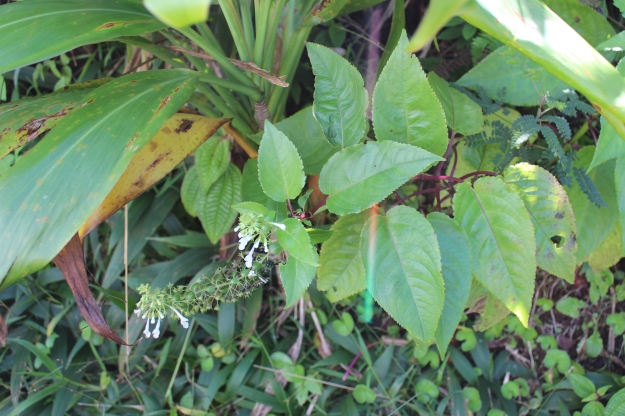Hi folks, I know it has been a long time between updates. We’re too busy restoring native forests! I do apologize for the lack of updates; we are not a defunct project by any means. In fact, I just created a page with before and after photos. You can find it here. And again, feel free to join us! We meet at the Kalawahine trailhead every Sunday at 9 AM.
12/11/2021 landslide update
Just letting folks know, as far as I’m aware Roundtop Dr is still closed from a landslide that occurred during the recent storm. We are meeting at the Kalawahine trailhead at 9 AM instead.
Every Sunday Its Something New
There’s something new every Sunday at the site. It might be the arrival of a truckload of mamaki plants (literally a gracious donation of a truckload of plants!) Or, just two weekends ago, we had 30 high school students from across the state spend the morning with us, weeding, planting and learning about native plants. Some days its sunny and hot, so we work in the cool shade with the breezes that can only be found at higher altitudes. When there are rain showers, we are treated to rainbows and glistening green foliage. Some days there are only a handful of us at the site – and other days we have lots of volunteers to help out with all sorts of activities. There is always something new happening at the site – but our appreciation of all those who help out never changes. Come join us – any Sunday!
An unexpected surprise
One nice thing about restoring a remnant native forest is the chance to come across something cool. We can be weeding through a patch of thimbleberry when we might come across a naupaka (Scaevola gaudichaudiana) or an olapa (Cheirodendron trigynum) for instance. Well, about 2 years back, we had cut down a thick stand of monotypic bamboo. In that intervening time a lot of koa (Acacia koa) and mamaki (Pipturus albidus) came up and are doing well now. Nothing too shocking there. But what also came up in that clearing was this plant.
This is one of the native mints Phyllostegia glabra. It has not been recorded from our area in a long time. How did it get here? Perhaps somebody brought it. Or it got here on its own via endozoochorous means. Another interesting theory is that it was here all along, in the seed bank since before the bamboo encroached upon this part of the forest decades ago. Either way, we’ll take care of this native plant and hope there are many other species waiting in the seed bank for their chance in the sun…
The difference between hiking and hiking
So I wanted to talk about the difference between hiking and hiking. Can you see it? There are some significant structural differences; hopefully the next few paragraphs should make that a little bit clearer.
One neat form of hiking might focus a bit more on speed. Perhaps you’re hiking to a destination; maybe a waterfall or to a scenic spot. Maybe you have an ambitious miles long route in mind and you are limited by daylight. Or perhaps you simply want to beat your previous time.
Another form of hiking is for the plants. This way tends to be a lot slower. When I hike for the plants, there have been occasions when I stop ever few feet. It can make a 1 mile hike take 8 hours.
The difference is perspective. I say that with a finality and rhetorical flourish that, to some people, might make the title seem like a tease and this post nothing more than a joke. But, frankly, it’s an important designation. Because one of those big structural differences is footfalls.
In many forms of hiking where you place your foot is processed subconsciously. Your immediate goals for your feet can typically be (a) stay on the trail and (b) don’t fall. The wonders of human body allow that fairly complex biomechanical process to be accomplished without you even giving it much thought. It can jump to active thinking in instances like large obstacles, say fallen trees or slippery rocks, are blocking the path which make the chance of falling much greater.
Here at Manoa Cliff, when I hike, I add another goal: (c) don’t step on the native plants. It can fluster some people initially because now that subconscious process is taking more thought. It can be especially frustrating when you’re not sure what plant is what. Our wonderful group of volunteers do what we can to make that process easier. We flag a lot of plants and help with plant identification. If you do it long enough, even (c) starts becoming intuitive.
There is room for error though. This isn’t like a form of hiking where you are going through a minefield or even free scaling El Capitan. In those instances, every single footfall is calculated and thought through well in advance. There are only a few places around some endangered native plants where you have to hike in that form, but for the most part, we are more forgiving than a landmine.
So, there’s hiking, then there’s hiking, and then there is hiking. You can hike this way, it is preferable to hike this other way and perhaps hiking the last way is overkill. I hope after reading this post, those differences are a little more apparent.
New Website
It has been a while, but we’ve finally been able to update our website. Hopefully, we’ll be able to update the work being done at the site more regularly. Stay tuned for more information!


